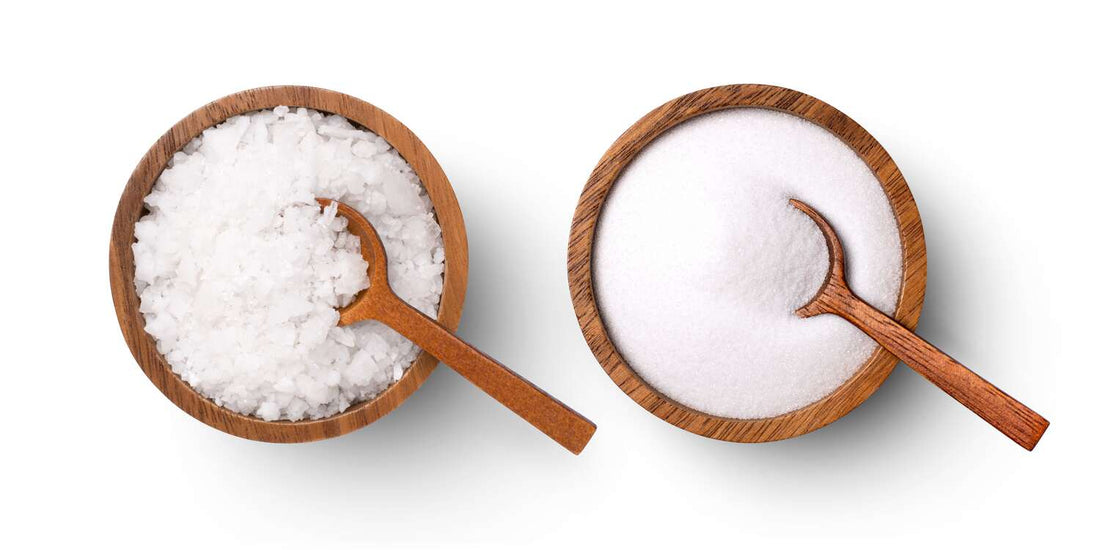Salt – a humble yet indispensable mineral that has graced our tables and tantalised our taste buds across cultures and epochs. From preserving foods to seasoning culinary delights, salt has been an essential component of the human diet since ancient times. Its value was so immense that entire trade routes and wars were waged in its pursuit, earning the revered moniker "white gold."
In today's modern culinary landscape, two varieties of salt take centre stage: sea salt, the ancient and elemental salt harvested from vast oceanic expanses, and table salt, the refined and processed product born from human ingenuity. While both ultimately serve to enhance flavours, their distinct origins, production methods, and properties distinguish them, sparking thought-provoking discussions among gourmets and health-conscious individuals alike. This comprehensive guide aims to unveil the intricacies of sea salt and table salt, delving into their composition, production, nutritional profiles, culinary applications, health considerations, and environmental impact. By the end, you'll possess a deeper understanding of these essential culinary companions, empowering you to make informed choices that cater to your palate, wellness goals, and ethical values.
Composition and Production
How sea salt is made
Extraction process (evaporation of seawater)
The creation of sea salt is a testament to nature's artistry. Through an age-old process, seawater is carefully drawn from the ocean's embrace and channelled into shallow evaporation ponds or salt marshes. As the sun's radiant rays dance upon the surface, the water gradually evaporates, leaving behind a crystalline bounty of sea salt, infused with a myriad of natural minerals and trace elements.
Natural minerals and trace elements
Unlike its refined counterpart, sea salt retains a rich tapestry of minerals and trace elements, each imparting a distinct flavour nuance and potential health benefit. From the robust flavours of potassium and magnesium to the subtle notes of iron and zinc, sea salt is a veritable treasure trove of nature's bounty.
Learn more about the various health benefits of sea salt by reading our post : Sea Salt and Hydration: Separating Fact from Fiction
How table salt is made
Mining and refining process
Table salt, on the other hand, undergoes a transformative journey from its primordial origins. Extracted from subterranean salt deposits or through the evaporation of saltwater, the raw salt undergoes a rigorous refining process. This intricate procedure strips away the natural minerals and trace elements, leaving behind a pure, crystalline form of sodium chloride.
Addition of anti-caking agents and iodine
To ensure free-flowing granules and prevent clumping, table salt is often fortified with anti-caking agents, such as calcium silicate or magnesium carbonate. Additionally, many brands incorporate iodine, a vital mineral essential for thyroid health and cognitive function, addressing the widespread deficiency of this nutrient in modern diets.
Nutritional Differences
Mineral content in sea salt
Sea salt's allure extends beyond its distinctive flavour profile; it boasts a treasure trove of naturally occurring minerals and trace elements. These essential nutrients play crucial roles in various bodily functions, from regulating fluid balance and muscle contractions to supporting immune function and bone health.
Mineral content in table salt
In contrast, table salt is predominantly composed of sodium chloride, with negligible amounts of other minerals or trace elements. While the refining process ensures a consistent flavour and texture, it strips away the natural complexity and potential health benefits found in its unrefined counterpart.
Sodium levels and implications for health
Both sea salt and table salt are predominantly composed of sodium, a mineral essential for various bodily functions but potentially detrimental when consumed in excess. However, sea salt tends to have a slightly lower percentage of sodium overall compared to table salt. This is because sea salt contains various other trace minerals from the sea water it is derived from, whereas table salt is mostly just sodium chloride after processing removes other minerals. While the difference in sodium levels is relatively small, it does mean that for the same volume, sea salt provides slightly less sodium than table salt. Regardless, moderation and mindful consumption are vital for maintaining optimal health with either variety of salt.
Culinary Applications
Flavour profiles
Subtlety and complexity of sea salt
Sea salt's allure extends far beyond its nutritional qualities; it is a true culinary masterpiece. Its delicate, nuanced flavours and intricate mineral profiles lend depth and complexity to dishes, elevating them to new realms of gastronomic delight. From the robust notes of Fleur de Sel to the floral hints of Camargue sea salt, each variety offers a unique flavour journey.
Consistent flavour of table salt
In contrast, table salt delivers a consistent, familiar flavour profile. Its uniformity and predictability make it a reliable choice for everyday cooking and baking, where precise measurements and replicable results are paramount. While it may lack the nuances of its sea-derived counterpart, table salt remains a trustworthy culinary companion for those seeking a dependable flavour enhancer.
Textural differences
Sea salt: flakes, crystals, and grains
Sea salt's allure extends beyond its flavour; its textural diversity is a feast for the senses. From delicate flakes that melt on the tongue to substantial crystals that crunch with each bite, sea salt offers a delightful range of textures. These varied forms allow chefs to experiment with garnishes, crusts, and finishing touches, adding an extra dimension of sensory delight to their creations.
Table salt: fine grains
Table salt, with its fine, uniform grains, excels in applications where even distribution and seamless integration are paramount. From seasoning dishes during cooking to baking, where precise measurements are crucial, table salt's consistent texture ensures reliable and predictable results every time.
Health Considerations
Impact on blood pressure and cardiovascular health
While both sea salt and table salt are predominantly composed of sodium, their potential impact on blood pressure and cardiovascular health remains a topic of ongoing scientific debate. Some studies suggest that the presence of additional minerals in sea salt may help mitigate the adverse effects of sodium on blood pressure, while others argue that the overall sodium content is the primary concern, regardless of the salt variety.
Iodine supplementation and thyroid health
One notable advantage of table salt lies in its iodine fortification. Iodine is a crucial mineral for thyroid function, and its deficiency can lead to various health issues, including goitre and impaired cognitive development. By consuming iodized table salt, you can safeguard your thyroid health and ensure adequate iodine intake. However, it's worth noting that there are natural alternatives to artificially fortified iodine. Certain sea vegetables like seaweed are rich in iodine and can be incorporated into salt, offering not only thyroid support but also a distinct taste and additional health benefits from the seaweed's nutrient profile. This provides an option for those seeking a more natural source of this essential mineral.
Myths and misconceptions about natural salts
It's important to address the pervasive myths and misconceptions surrounding natural salts. While some varieties, such as Himalayan pink salt or fleur de sel, are marketed as healthier alternatives, their purported benefits often lack robust scientific evidence. Moderation and a balanced diet remain the keys to optimal health, regardless of the salt variety consumed.
Environmental Impact
Sustainability of sea salt production
The production of sea salt is often praised for its sustainable and eco-friendly nature. Harvested through the evaporation of seawater, this process has a minimal environmental footprint and relies on renewable resources. Additionally, many sea salt producers employ traditional, artisanal methods that preserve local ecosystems and support coastal communities.
Environmental concerns of table salt mining
On the other hand, the mining of rock salt for table salt production can raise environmental concerns. These operations can potentially disrupt local ecosystems, contribute to soil erosion, and consume significant amounts of energy and resources. However, responsible mining practices and stringent environmental regulations aim to mitigate these impacts.
Ethical considerations in salt sourcing
Beyond environmental factors, ethical considerations also play a role in salt sourcing. You are likely increasingly conscious of the working conditions and fair trade practices associated with your food products. Responsible salt producers prioritise ethical sourcing, ensuring fair wages, safe working environments, and respect for local communities and traditions.
The Unique Qualities of Isle of Skye Sea Salt
As a purveyor of premium Scottish sea salt, Isle of Skye Sea Salt stands as a shining example of artisanal excellence. Harvested from the pristine waters of the Hebridean coastline, this salt captures the essence of the region's rugged beauty and untamed spirit. While inspired by ancient salt-making traditions, notably those from Brittany and the Mediterranean, the methods employed have been carefully adapted to the cooler climate of the Isle of Skye. The evaporation process relies solely on the wind and sun, making it more environmentally friendly than some other sea salt production methods. Crafted using these time-honoured yet regionally-tailored techniques, Isle of Skye Sea Salt is an authentic, unrefined treasure that celebrates the natural complexity of the ocean's bounty. With a delicate balance of minerals and a distinctive flavour profile, this salt elevates any dish it graces, transporting your taste buds to the windswept shores of the Scottish Highlands.
Conclusion
In the eternal dance between sea salt and table salt, there is no definitive victor, as both offer unique qualities and cater to different culinary preferences and health considerations. Ultimately, the choice between these two sodium-rich companions lies in your hands, guided by your taste buds, wellness goals, and ethical values. Whether you opt for the nuanced flavours and natural goodness of sea salt or the consistent reliability of table salt, one truth remains: a pinch of salt can transform a dish from ordinary to extraordinary.

